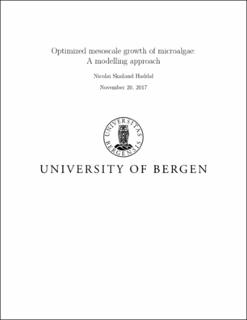| dc.description.abstract | Photosynthesis is a process that uses water, carbon dioxide and light to create sugar and oxygen. Sugar and oxygen is then used by the cell for maintenance and growth purposes through cellular respiration. We would then expect the growth rate of an algae culture to depend on the amount of radiation available.
This thesis explores how the growth of three strains of P. tricornutum, named FITO, M28 and B58, depends on the amount of radiation received in the form of irradiance, as well as the temperature and the pH. The cultures are grown in bags on a rooftop, the irradiance is measured with a cosine irradiance meter, samples are taken from the algae culture to determine the dry weight or biomass, and the temperature and pH are measured automatically several times during the day. We also create a model that describes the biomass as a function of time, and this model is fitted to the data points we have for biomass.
The correlations between average growth and average temperature and between average growth and average pH are not similar between the strains, however, the correlation between average growth and average irradiance is almost the same for each strain. We also find that the irradiance used can be either in the form of photosynthetically available radiation (PAR) or photosynthetically usable radiation (PUR); the correlation between average growth and PAR is almost identical to the correlation between average growth and PUR.
In our model we have certain parameters, and by fitting the model curve to our different measurement series we get a set of parameter values for each series. We investigate how the maximum growth rate of our model depends on the model parameters, and also how these model parameters depend not only on irradiance, temperature and pH, but on each other. All the correlations between these parameters and between the parameters and irradiance, temperature and pH are weak, the largest ones being between 0.2 and 0.3.
We also find that two of the function parameters, the maximum production and the absorption cross section, have a certain value each for every measurement series that maximizes the maximum growth rate of the model function. We then compare the average fitted parameter values with the average optimal parameter values, and find that the average fitted parameter values for the maximum production and the absorption cross section are 0.74 d-1 and 5.7 dm2 g-1, respectively, while the average optimal parameter values for the maximum production and the absorption cross section are 4.5 d-1 and 3.2 dm2 g-1, respectively. That is, the average fitted the maximum production is smaller than the average optimal the maximum production, while the average fitted the absorption cross section is higher than the average optimal the absorption cross section. To optimize growth, then, we should consider finding other strains and maybe species of algae that have different average values of the maximum production and the absorption cross section.
Another interesting result is that the growth per area, according to the model, is constant with depth. That means that model-wise there are not any limitations on the depth, at least not for bags that are between 1 cm and 1 m deep. That is, to maximize growth, we should look at other parameters, and look at the depth from a more practical viewpoint. | en_US |
